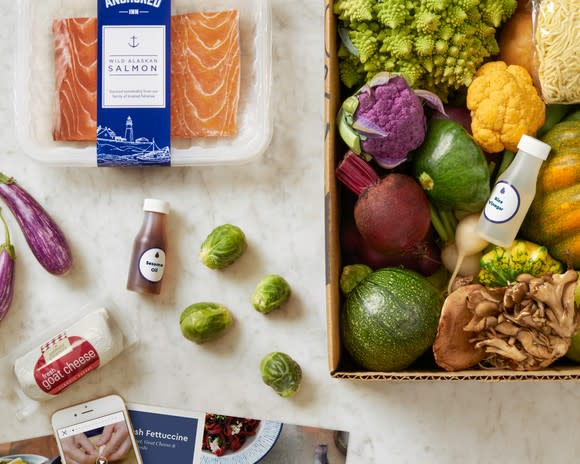Blue Apron Wants to Partner With Its Biggest Competitors
Blue Apron (NYSE: APRN) is starting to think outside the box.
The company said it will start distributing its meal kits through supermarkets later this year. The news comes about a week after Walmart (NYSE: WMT) announced plans to sell its own meal kits in 250 stores this month and 2,000 stores by the end of the year. Meanwhile, Blue Apron faces growing competition from grocery store owners experimenting with selling their own meal kits, including Kroger (NYSE: KR), Albertsons, and Amazon (NASDAQ: AMZN).
But with companies already selling their own meal kits, is Blue Apron's next step too little, too late?

Image source: Blue Apron.
Eating into margins
One of Blue Apron's biggest challenges is improving its gross margin. Gross margin shrank to 29% in 2017, down from 33% in 2016.
Last month, Blue Apron CEO Brad Dickerson outlined three areas the company can improve in order to increase its gross margin: reducing food waste, increasing labor efficiency with automation, and saving money on packaging and delivery.
Wholesaling to supermarkets will help cut down on shipping expenses, but it will cut into Blue Apron's top line. Blue Apron sells its meal kits online for about $20 for each two-serving kit.
Walmart, Kroger, and Amazon have all shown a willingness to undercut that price point. Walmart's meal kits cost between $8 and $15 for two servings. Blue Apron can rely on its brand strength for premium pricing, but investors shouldn't expect a significant markup over its subscription pricing for one-off in-store purchases.
Even if it can offset some of the wholesale pricing with more efficient shipping, it seems very likely Blue Apron's partnerships with supermarkets will eat into gross margin due to the lower revenue per kit.
Getting into stores
Blue Apron didn't give any details about which stores it plans to partner with. It might have trouble getting into stores that already offer in-house meal kits, which also happen to be the largest national grocery chains.
Walmart is historically a tough negotiator on pricing, but it does offer unparalleled distribution. Walmart accounts for nearly 15% of grocery sales in the United States. That's more than Kroger and Albertsons combined.
Importantly, though, even if Blue Apron does get its meal kits into Walmart stores, the big-box retailer caters to an entirely different demographic than Blue Apron. Premium meal kits might not sell well at Walmart.
Blue Apron kits would fit in much better at a grocery store like Whole Foods. But Amazon is ruthless when it comes to selling competitors' products. If Amazon is serious about the meal kit space, there's practically no chance it will sell Blue Apron kits short of acquiring the entire operation.
With strong competition in stores already, Blue Apron may have a tough time finding shelf space. That means higher marketing expenses and bigger sacrifices on the top line.
A marketing expense in cost of goods sold
Blue Apron investors might want to consider the company's move to sell its meal kits in stores as a marketing expense on top of a way to increase distribution. Selling kits in stores at the very least gets the Blue Apron brand in front of more people.
"The access to consumers is much broader in this avenue than the avenue we've been operating in the past," Dickerson told The Wall Street Journal.
To that end, stocking grocery store shelves could be an efficient marketing method. It will notably shift the expense higher in the income statement into cost of goods sold instead of operating expenses, but the payoff could be just the same.
That said, Blue Apron will have to convince customers who try its product from supermarkets to subscribe online. And considering its track record in customer retention, I wouldn't bet on a significant payoff.
More From The Motley Fool
John Mackey, CEO of Whole Foods Market, an Amazon subsidiary, is a member of The Motley Fool’s board of directors. Adam Levy owns shares of Amazon. The Motley Fool owns shares of and recommends Amazon. The Motley Fool has a disclosure policy.

 Yahoo Finance
Yahoo Finance 